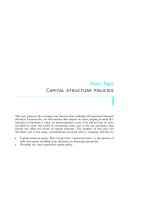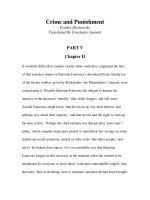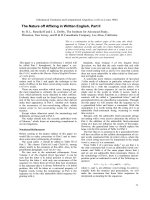Part II chapter 2 poverty VN
Bạn đang xem bản rút gọn của tài liệu. Xem và tải ngay bản đầy đủ của tài liệu tại đây (537.75 KB, 19 trang )
Poverty Reduction In Vietnam
With New Challenges
Prof.,Dr. Nguyen Van Nam
Nguyen Ngoc Son, Ph.D
Pham Truong Hoang, Ph.D
National Economics University
Today’s Menu
The situation of poverty and poverty
reduction in Vietnam
Pro – poor policy in Vietnam
New factors influencing on poverty in
Vietnam
Threats of poverty reduction in Vietnam
Policy recommendations
Poverty line
The
poverty indicator
expenditure method:
based
on
the
Consumption basket needed to secure 2100
calories per day to each member (VHLSS,
GSO).
Ministry of Labor, Invalids and Social Affairs
(MOLISA)
260.000 VND for Urban Area and 200.000
VND for Rural Area
1 USD (PPP) International poverty line
Poverty reduction in Vietnam
during the 1993-2006 period
70
60
58.1
50
40
37.4
30
28.9
20
18.1
15.9
10
0
1993
1998
2002
2004
2006
Poverty distribution in Vietnam
Poverty rate among regions in
Vietnam
Region
1993
1998
2002
2004
2006
1
Red River Delta
62.7
29.3
22.4
21.1
8.8
2
North
81.5
64.2
43.9
29.4
26.2
North East
na
62.0
38.4
31.7
25.0
North West
na
73.4
68.0
54.4
49.0
3
North Central Coast
74.5
48.1
43.9
41.4
29.1
4
South Central Coast
47.2
34.5
25.2
21.3
12.4
5
Central Highlands
70.0
52.4
51.8
32.7
28.4
6
South East
37.0
12.2
10.6
6.7
5.7
7
Mekong River Delta
47.1
36.9
23.4
19.5
10.2
All
58.1
37.4
28.9
19.5
15.9
Geographical distribution of poverty
in Vietnam
90
80
70
1993
1998
2002
2004
2006
60
50
40
30
20
10
C
N
or
th
Source: VLSS, VHLSS (1993 – 2006)
A
ll
W
es
en
t
tra
So
lC
ut
oa
h
C
st
en
tra
lC
Ce
oa
nt
st
ra
lH
ig
hl
an
ds
S
M
ou
ek
th
on
Ea
g
st
R
iv
er
D
elt
a
Ea
st
N
or
th
N
or
th
N
or
th
Re
d
R
iv
er
D
el
ta
0
Poverty rate and poverty gap in
Vietnam 1993-2006
1993
1998
2002
2004
2006
Poverty rate
Urban
Rural
Kinh và Chinese
Ethnic minorities
58.1
25.1
66.4
53.9
86.4
37.4
9.2
45.5
31.1
75.2
28.9
6.6
35.6
23.1
69.3
19.5
3.6
25.0
13.5
60.7
15.9
3.8
20.3
10.3
52.3
Food poverty
Urban
Rural
Kinh và Chinese
Ethnic minorities
24.9
7.9
29.1
20.8
52.0
15.0
2.5
18.6
10.6
41.8
10.9
1.9
13.6
6.5
41.5
7.4
0.8
9.7
3.5
34.2
6.7
1.2
8.7
3.2
29.2
Poverty gap
Urban
Rural
Kinh và Chinese
Ethnic minorities
18.5
6.4
21.5
16.0
34.7
9.5
1.7
11.8
7.1
24.2
6.9
1.3
8.7
4.7
22.8
4.7
0.7
6.1
2.6
19.2
3.8
3.2
4.9
2.0
15.4
Source: VLSS, VHLSS (1993 – 2006)
Ethnicity disparities in poverty
Poverty rate
Poverty gap
100
40
90
35
80
All
70
30
All
25
60
Kinh anh
Chinese
50
40
Ethnic
minorities
30
20
Kinh anh
Chinese
20
15
Ethnic
minorities
10
5
10
0
0
1993
1998 2002 2004
2006
Source: VLSS, VHLSS (1993 – 2006)
1993
1998
2002
2004
2006
Comparable Poverty Rates in Selected Countries
Country
Vietnam
Malaysia
Thailand
Russia
Sri Lanka
Indonesia
Mexico
Brazil
Mongolia
Philippines
China
Laos
India
GDP per capita in
PPP$
3,300
8,922
6,788
11 630
5, 010
3,138
11,410
8,800
1,651
4,021
4,475
1,678
2,571
Percent of the population living with
less than one PPP$ per day
4.9 (2006)
< 2.0 (2001)
< 2.0 (2002)
< 2.0 (2002)
5.6 (2002)
7.5 (2002)
3.0 (2004)
7.5 (2004)
10.8 (2002)
14.8 (2003)
9.9 (2004)
26.3 (2002)
34.3 (2005
Comparable Poverty Reduction in
Selected Countries
Country
Period
Vietnam
1993-1998
1993-1998
1992-1996
1994-1997
1993-1998
1992-1997
1994-1997
1990-1996
1992-1996
East Asia and Pacific
Bangladesh
Cambodia
China
India
Philippines
Indonesia
Thailand
Percent-point
reduction per
year
-4.1
-2.0
-1.7
-1.0
-2.5
-1.4
-1.3
-2.1
-1.0
Average
growth of per
capita GDP
6.8
5.6
2.8
2.6
10.4
3.8
1.9
6.4
7.2
Main Poverty Reduction Policies
Year
Decision
Policy content
1998
5/1998/QĐ-TTg
•
Listed poverty reduction as one of 7 National Target
Programs (NTPs)
1998
133/1998/QĐ- TTg
•
•
NTP for poverty reduction in 1998-2000
Poverty reduction in the nation’s strategy
1998
135/1998/QĐ- TTg
•
NTP on socio-economic development for special difficult
communes – PROGRAM 135
1998
327/1998/QĐ- TTg
•
NTP for planting 5 mill hectare of forest
2001
71/2001/QĐ- TTg
143/2001/QĐ-TTg
•
NTPs for poverty reduction and job creation
2006
07/2006/QĐ-TTg
•
Second phase of program 135
New factors influencing to poverty
in Vietnam
Economic growth slowdown
Globalization
Inflation, especially increase of food price
Financial turbulence
Food weight in CPI in some
countries
Economy
Share (%)
1
China
33.20
2
Hong Kong (China)
26.94
3
India
57.00
4
Indonesia
42.30
5
Korea
14.00
6
Malaysia
30.00
7
Philippines
46.58
8
Singapore
23.38
9
Taipei (China)
25.00
10
Thailand
32.71
11
Vietnam
42.85
Source: ADB, 2008.
The share of food expenditure by
household group of Vietnam in 2006
70.0
60.0
50.0
40.0
30.0
20.0
10.0
0.0
Quintile 1
Quintile 2
Source: VHLSS (2006)
Quintile 3
Quintile 4
Quintile 5
Inflation in 2007 and 3Q/2008
Foodstuff
Health and
Personal
care
Education
15.4
21.16
7.05
1.97
36.55
48.45
8.61
3.03
Year
CPI
All Items
Food
2007
12.63
3Q/2008
22.76
Source: GSO, Today’s Price Index, 2008, Sep. 2008
Effect of food price increase
12% urban households (including 27% poor one)
46% rural households
are net food buyer
Food price increase by 10% Î
1.7% households welfare increased
0.6% poverty reduced
56% household worsen off (88% urban,46% rural)
Î Return toward poverty line
Threats of poverty reduction in
Vietnam
Low stability of the poverty alleviation process, more
people falling back into poverty
The gaps between the rich and the poor among
quintiles, between rural and urban areas and among
economic regions are quite distant and tends to
expand
Social security services does not reach the poor
(most wanted people); and government pro-poor
budget is not always get to them.
Slow implementation of Program 135 Phase II.
….
Policy recommendations
Give more economic opportunities for ethnic minority
and remote regions by distributing more state budget
to mountainous areas
Accelerate the development of small and mediumsize - enterprises and services in rural areas
Re-orientate land policy, especially in withdrawing
agricultural land to develop industrial park (IPs), golf
ground
Reform distribution policies
Improve the social security policies
Intensify the effect of the public service









